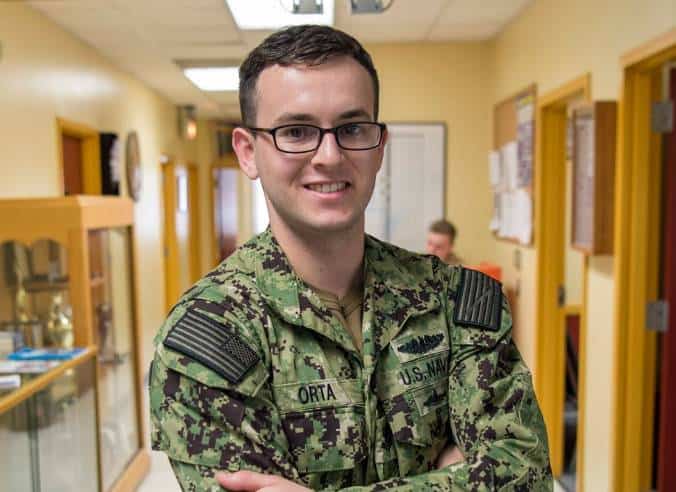By Chief Mass Communication Specialist Erica R. Gardner, Navy Office of Community Outreach
KINGS BAY, Ga. – As citizens of Orlando go about their daily lives, members of the U.S. Navy’s “Silent Service” submarine force work beneath the ocean’s waves, continuing a tradition that only a small fraction of military members will ever know: strategic deterrence.
Petty Officer 2nd Class Steven Orta, assigned to USS Florida, hails from Orlando, Florida, and is a 2015 graduate of Freedom High School who takes on the task to execute one of the Defense Department’s most important mission of strategic deterrence.
Orta is a missile technician stationed at the Naval Submarine Base Kings Bay, homeport to the Ohio-class ballistic-missile and guided-missile submarines.
“Naval Submarine Base Kings Bay is home to all East Coast Ohio-class submarines,” said Rear Adm. Jeff Jablon, commander, Submarine Group 10. “Team Kings Bay ensures our crews are combat ready when called upon, putting our submarine forces on scene, unseen.”
“I perform maintenance on the ship and maintain the weapon security aboard submarines,” Orta said.
Orta credits continued success in the Navy to many of the lessons learned in Orlando.
“I learned if you work hard and show that you are a diligent worker, people will respect you,” said Orta. “Do not let people push you around and be firm and not waver because it makes things easier in the long run.”
Guided-missile submarines (SSGNs) provide the Navy with unprecedented strike and special operation mission capabilities from a stealthy, clandestine platform, according to Jablon. Armed with tactical missiles and equipped with superior communications capabilities, SSGNs are capable of directly supporting combatant commander’s strike and Special Operations Forces (SOF) requirements. The Navy’s four guided-missile submarines, each displace 18,750 tons submerged. Each SSGN is capable of carrying 154 Tomahawk cruise missiles, plus a complement of heavyweight torpedoes to be fired through four torpedo tubes.
Orta is part of the boat’s Blue crew, one of the two rotating crews, which allow the boat to be deployed on missions more often without taxing one crew too much. A typical crew on this submarine is approximately 150 officers and enlisted sailors.
The first submarine was invented by Yale graduate, David Bushnell, in 1775 and provided the colonists with a secret weapon in the form of a one-man wooden craft in an experimental submarine that was nicknamed the Turtle.
Although Bushnell’s efforts were unsuccessful in attempts to blow up British vessels during the American Revolution George Washington said of the Turtle, “I then thought, and still think, that it was an effort of genius.”
U.S. submarines may not be what some have imagined. Measuring 560 feet long, 42-feet wide and weighing more than 16,500 tons, a nuclear-powered propulsion system helps push the ship through the water at more than 20 knots (23 mph).
Because of the demanding environment aboard submarines, personnel are accepted only after rigorous testing, according to Navy officials. Submariners are some of the most highly-trained and skilled people in the Navy. Regardless of their specialty, everyone has to learn how everything on the ship works and how to respond in emergencies to become “qualified in submarines” and earn the right to wear the coveted gold or silver dolphins on their uniform.
Serving in the Navy means Orta is part of a world that is taking on new importance in America’s focus on rebuilding military readiness, strengthening alliances and reforming business practices in support of the National Defense Strategy.
A key element of the Navy the nation needs is tied to the fact that America is a maritime nation, and that the nation’s prosperity is tied to the ability to operate freely on the world’s oceans. More than 70 percent of the Earth’s surface is covered by water; 80 percent of the world’s population lives close to a coast; and 90 percent of all global trade by volume travels by sea.
“Our priorities center on people, capabilities and processes, and will be achieved by our focus on speed, value, results and partnerships,” said Secretary of the Navy Richard V. Spencer. “Readiness, lethality and modernization are the requirements driving these priorities.”
Though there are many ways for sailors to earn distinction in their command, community, and career, Orta is most proud of the work he has done with the command. He is about to go on his fifth patrol and is thriving in the difficult work environment.
As a member of one of the U.S. Navy’s most relied upon assets, Orta and other sailors know they are part of a legacy that will last beyond their lifetimes providing the Navy the nation needs.
“It shows I am capable of doing more than what is given to me,” said Orta. “I can multi-task and I feel better my friends and family are safe back at home because of what I do in the Navy,” Orta said.
Jeff Atwater is an avid fisherman and boating enthusiast. He is particularly interested in the environment and how to keep the planet safe.


